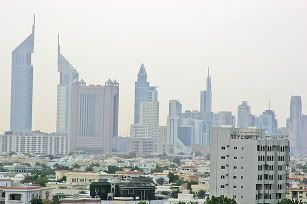
The October 17, 2005 issue of The New Yorker - the annual art/architecture special - includes some interesting articles. In the course of reading "Salesman," Nick Paumgarten's profile on New York dealer Leo Koenig, I was inspired (many times over) to write something reactionary. After allowing the reading to digest, however, I've decided to write very little. The Art World groupie in me enjoyed the elements of voyeurism - peeking in on other artist/dealer relationships is always intriguing - but such superficial thrills are temporal and, in the end, the piece was satisfying only as a guilty pleasure.
More exciting was Ian Parker's report about Dubai's rapid development ("The Mirage"). Parker describes this United Arab Emirates city as "a diagram of hormonally adolescent urban growth." His phrase evokes another, more familiar mess. With regard to thoughtless consumption, expansion and greed, Dubai paragons Las Vegas, Nevada. Passing through this latter city several years ago, my reaction against the town was so visceral that I almost forgave Theodore Kaczynski his transition from Luddite philosopher to terrorist - and, although I have never visited Dubai, photographs of the oil boom development(1) pique me. I suppose that garish displays of wealth or power generally offend my sensibility and when this variety of peacock trumpeting is coupled with a disregard for the environment, I am deeply saddened, even embittered.
Parker provides many examples of this unholy coupling. Reading the selection that follows, keep in mind that Dubai, like it's American sister city, is in the desert, an ecosystem short on water and long on heat.
"While I was in Dubai, I went to an early-evening meeting of the U.A.E.'s recently formed Green Building Council, held in the Grand Hyatt. I pushed open high double doors, and walked into a ballroom with a thirty-foot ceiling and multiple chandeliers, each with a hundred light bulbs. The outdoor temperature was more than a hundred degrees, but the air inside was almost uncomfortably cool. Although the room could easily have held a cocktail party for a thousand people, only twenty or so attended the meeting.If the irresponsible construction craze isn't troubling enough, city officials and U.A.E. leaders are determined to turn Dubai into a disposable economy, one dependent on foreign tourism and stockholder petroleum wealth. (Hamza Mustafa, General Manager of The World, a luxury development being constructed on artificial islands, says of his city, "Dubai is to Europeans like Miami is to New Yorkers.") In order to support such an arrangement while maximizing profits, cheap labor is imported from outside the U.A.E., and these laborers are given second-class rights, poor benefits - if any - and required to depart the country before reaching retirement age.
The environmental profligacy of Dubai is today most proudly expressed in the forthcoming indoor ski slope that is the defining feature of the new Mall of the Emirates. Encased inside a broad flattened tube that is visible for miles, it will be twelve hundred feet long: a steep, black diamond run of nine hundred feet, a forty-degree bend, then a gentler slope to the bottom. I went there before the refrigeration had begun: the snow-making machines had not yet been turned on. 'Obviously, it's going to be freezing here and a hundred and a twenty degrees outside, so we're going to be using a fair amount of electricity,' Phil Taylor, the chief executive of Ski Dubai...told me."
"The invitation that Dubai sends out to professionals - to British airline pilots and German bankers - is quite different. These favored expatriates buy or rent apartments in the glass-plated towers on Sheikh Zayed Road, or find homes in the generously named developments that Emaar has built in the otherwise featureless desert: the Lakes, the Springs, the Meadows. In these neighborhoods, lawns are perpetually misted by sprinklers, and babies squint into the sun as they are wheeled along brand-new sidewalks by young Sri Lankan nannies. 'We live in Wonderland,' Rola Zaarour, a young Lebanese-Canadian woman, told me. Zaarour, who is single and works in public relations, has a red convertible and describes herself, smilingly, as 'shallow.' She came to Dubai three years ago, and admitted that she had never seen most of the city's old downtown, where the streets narrow to create a souk-like atmosphere, and where Indian and Pakistani workers, on their days off, shop for radios and alarm clocks that they will one day carry home. 'I didn't come to Dubai for anything "real",' she said. 'I've already lived in real places.'"Rola Zaarour's escapist attitude, one shared by millions of people, risks undermining the now vulnerable supports of democracy and republicanism. Parker alludes to the conflict between the "real" and Zaarour's Wonderland with his article's title, "The Mirage." Too many of us prefer to believe in the illusory; the alternative, accepting that freedom and peace require substantial commitment and effort, was once a mainstream ideal, but today we market leisure in place of hard earned satisfaction. Las Vegas and Dubai are temples to this immoral tide; it pains me to look upon them, whether in photographs or in person.
(1) "In the seventies, oil production rose as global oil prices increased tenfold - to the country's spectacular advantage...Dubai International Airport was expanded on a scale that seemed preposterous at the the time, and, if for nothing else, the city soon became renowned as a glittering duty-free mall stumbled upon during 3 A.M. stopovers between East and West."
Photo credit: OmanVistas.org

No comments:
Post a Comment